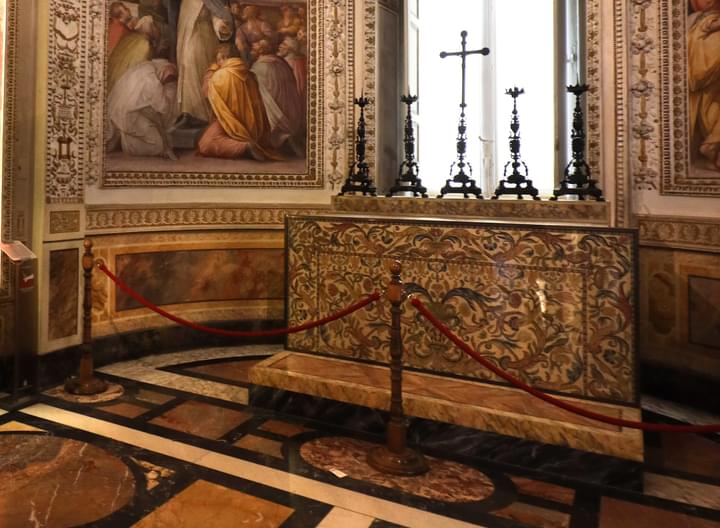About Chapel of St. Peter Martyr
Explore Chapel of St. Peter Martyr
Frescoes by Andrea da Firenze: The walls of the chapel are adorned with a cycle of frescoes depicting scenes from the life of Saint Peter Martyr. Painted by Andrea da Firenze in the mid-14th century, these frescoes are a masterpiece of Gothic art and a testament to the skill of this talented artist.
Wooden Choir Stalls: The choir stalls in the chapel are a magnificent example of Gothic woodcarving. Created by Fra Giovanni da Verona in the 14th century, they are adorned with intricate carvings of saints, angels, and other religious motifs. Visitors can admire the craftsmanship of these stunning wooden pieces.
The Altarpiece by Giovanni del Biondo: The altarpiece in the chapel is a stunning work of art created by Giovanni del Biondo in the early 15th century. It depicts the Madonna and Child surrounded by angels and saints, and is a testament to the skill of this talented artist.
The Crucifix by Giambologna: One of the most striking features of the chapel is the wooden crucifix created by Giambologna in the late 16th century. This sculpture is a powerful representation of the crucifixion and is an important example of the artist's skill in creating realistic and emotionally charged works of art.
The Tomb of Baldassare Cossa: The chapel also contains the tomb of Baldassare Cossa, who was the antipope John XXIII. The tomb is a magnificent example of Renaissance funerary art and is adorned with intricate carvings and sculptures.
The Rose Window: The chapel's rose window is a stunning example of Gothic stained glass. Created in the mid-14th century, it depicts scenes from the life of Saint Peter Martyr and is a testament to the skill of the artists who created it.
The Chapel's Vaulted Ceiling: The chapel's vaulted ceiling is a marvel of Gothic architecture. Adorned with intricate ribs and painted decorations, it is a testament to the skill of the builders who created this stunning space.
The Statue of Saint Peter Martyr: The chapel also contains a statue of Saint Peter Martyr, the Dominican friar who was martyred in the 13th century. Created in the early 15th century, the statue is a powerful representation of the saint's devotion to his faith.
The Frescoes in the Apse: The frescoes in the chapel's apse depict scenes from the life of Christ and are a stunning example of Gothic art. Created by Andrea di Bonaiuto in the mid-14th century, they are a testament to the skill of this talented artist.
Must Read: Gallery of Maps
Book Your Vatican Museums Tickets
FAQs Of Chapel of St. Peter Martyr
What is the history of the Cappella di San Pietro Martire?
The Chapel of San Pietro Martire was built in the 14th century as a burial chapel for the noble Scrovegni family. It was commissioned by Enrico Scrovegni, a wealthy merchant and banker in Padua, to expiate his father's usury. The chapel was designed by the famous Italian painter and architect Giotto di Bondone, who is considered the father of Renaissance art. The chapel is renowned for its stunning frescoes, which are considered some of the most important examples of Western art.
Also Checkout: Dress Code of Vatican
What is the significance of the frescoes in the Cappella di San Pietro Martire?
The frescoes in the Cappella di San Pietro Martire are significant because they represent a crucial moment in the development of Western art. Giotto's frescoes are considered a masterpiece of Italian art, and they were a turning point in the history of painting. The frescoes depict scenes from the life of Christ, including the Annunciation, Nativity, Crucifixion, and Resurrection. They are characterized by their naturalism, which was a departure from the stylized forms that had dominated art up until that point.
Must Read: Paintings in Vatican Museums
How long did it take to complete the frescoes in the Cappella di San Pietro Martire?
The frescoes in the Cappella di San Pietro Martire were completed in a relatively short period of time, considering their complexity and beauty. Giotto began work on the chapel in 1303 and completed it in 1305, a remarkable feat given the size and intricacy of the frescoes. The speed of the work is a testament to Giotto's skill as an artist and the dedication of the Scrovegni family to the project, to visit the Cappella di San Pietro Martire you must have Vatican Museums Ticket .
Also Read: Vatican Museums at Night
What is the condition of the frescoes in the Chapel of San Pietro Martire?
The frescoes in the Chapel of San Pietro Martire have undergone extensive restoration over the years to preserve their beauty and ensure their longevity. In the 19th and 20th centuries, the frescoes were restored several times, with the most recent restoration taking place in the 1990s. The restorations have been carefully carried out to maintain the original colors and textures of the frescoes, while also repairing damage caused by age and environmental factors.
Suggested Read: Best Time to Visit Vatican Museums
Can visitors take photographs inside the Cappella di San Pietro Martire?
No, photography is not allowed inside the Cappella di San Pietro Martire This is to protect the frescoes from damage caused by flash photography and to ensure the preservation of the chapel for future generations. Visitors are welcome to admire the beauty of the frescoes with their own eyes and are encouraged to take in the full experience of the chapel without the distraction of cameras or phones.
Suggested Read: History of Vatican City
.png?w=auto&h=400)
